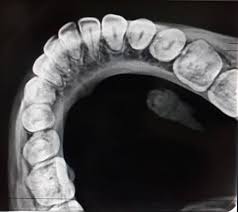Occlusal x-rays

Occlusal x-rays
Occlusal X-rays show the roof or floor of the mouth and are used to find extra teeth, teeth that have not yet broken through the gums, jaw fractures, a cleft palate, cysts, abscesses or growths.
Occlusal X-rays may also be used to find a foreign object.
FAQ x-ray
Recommendations for each individual depend on their current dental and medical history as well as the condition of their mouth. Those with increased risk for dental problems may need x-rays as often as every six to twelve months, while others with no recent dental issues may require them less often. Taking dental x-rays is a crucial part of a complete examination. Without them, cavities, infiltration under fillings or crowns, bone loss chronic infections, and other abnormalities of the teeth or jaw can go undetected. In fact, x-rays are a vital preventative tool to ensure that small problems don’t progress into more extensive (and expensive) ones! It is our recommendation that our patients have their Bitewing x-rays once every two years and a Panoramic every 5 years. Other types of x-rays such as a 3D CBCT or a Lateral Ceph may need to be taken based on treatment needs and insurance requirements (for claim submissions or Pre-determinations).
The amount of radiation from dental x-rays is negligible. Four Bitewing x-rays have been estimated to be the amount of radiation received from a 2 hour airplane flight. Radiation exposure is typically measured in units called millirem (mrem). Each year, the average person receives about 620 mrem of radiation from all natural and man-made sources
combined. The amount of radiation you get from a single digital Bitewing x-ray is 0.1 mrem.
Compare this to:
- One plane ride from Malta to mainland Europe, round trip: 5 mrem
- Sunlight & other cosmic radiation: 35 mrem
- Food and water for 1 year: 40 mrem
- Breathing normally for 1 year (from radon in air): 228 mrem
- 1 full body CT scan: 1000 mrem
- Digital x-rays significantly reduce the level of radiation, by as much as 70-80%, utilizing sensors that replace traditional photographic x-ray film.
- Your dentist uses the “As Low As Diagnostically Achievable” (ALADA) Method to
customize x-ray frequency based on your risk factors to minimize your exposure.
Tell your dentist if you may be pregnant, or you have been told to limit x-ray exposure.

Clinic Opening Hours
- Monday - Friday 08:00AM - 07:00PM
- Saturday 08:00AM - 04:00PM
- Sunday / Holidays Closed

